1998 CHEVROLET ASTRO phone
[x] Cancel search: phonePage 46 of 414

Downloaded from www.Manualslib.com manuals search engine Adding Equipment to Your Air
Bag-Equipped Vehicle
@ If I add a push bumper or a bicycle rack to the
front of my vehicle, will it keep the air bags
from working properly?
A: As long as the push bumper or bicycle rack is
attached to your vehicle
so that the vehicle’s basic
structure isn’t changed, it’s
not likely to keep the
air bags from working properly in a crash.
@ Is there anything I might add to the front of the
vehicle that could keep the air bags from
working properly?
A: Yes. If y01- - Jd things that change your vehicle’s
frame, bumper system, front end sheet metal or
height, they may keep the air bag system from
working properly. Also, the
air bag system may not
work properly if
you relocate any of the air bag
sensors. If you have any questions about this,
you
should contact Customer Assistance before you
modify your vehicle. (The phone numbers and
addresses for Customer Assistance are in Step Two
of
the Customer Satisfaction Procedure in this manual.
See “Customer Satisfaction Procedure”
in the Index.)
Rear Seat Passengers
It’s very important for rear seat passengers to buckle up!
Accident statistics show that unbelted people in
the rear
seat are hurt more often in crashes than those who are
wearing safety belts.
Rear passengers who aren’t safety belted can be thrown
out of the vehicle in a crash. And they can strike others
in the vehicle who are wearing safety belts.
Rear Seat Outside Passenger Positions
Page 170 of 414
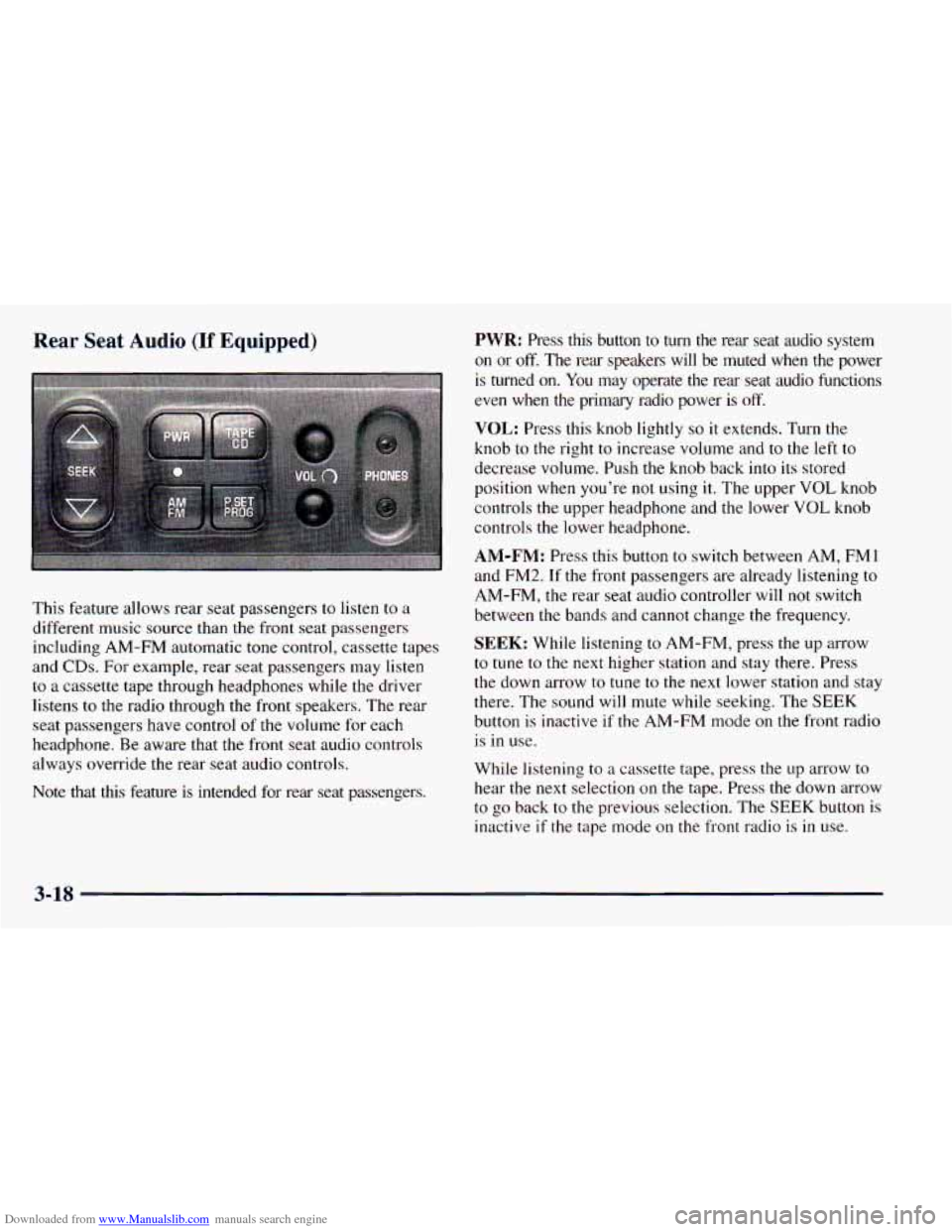
Downloaded from www.Manualslib.com manuals search engine Rear Seat Audio (If Equipped)
This feature allows rear seat passengers to listen to a
different music source than the front seat passengers
including AM-FM automatic tone control, cassette tapes
and
CDs. For example, rear seat passengers may listen
to a cassette tape through headphones while the driver
listens to the radio through the front speakers. The rear
seat passengers have control
of the volume for each
headphone. Be aware that the front seat audio controls
always override the rear seat audio controls.
Note that
this feature is intended for rear seat passengers.
PWR: Press this button to turn the rear seat audio system
on or off, The rear speakers will be muted when the power
is turned on. You may operate
the rear seat audio functions
even when the primary radio power is
off.
VOL: Press this knob lightly so it extends. Turn the
knob to the right to increase volume and to the left to
decrease volume. Push the knob back into its stored
position when you’re not using it. The upper
VOL knob
controls
the upper headphone and the lower VOL knob
controls the lower headphone.
AM-FM: Press this button to switch between AM, FM1
and
FM2. If the front passengers are already listening to
AM-FM, the rear seat audio controller will not switch
between
the bands and cannot change the frequency.
SEEK: While listening to AM-FM, press the up arrow
to tune to the next higher station and stay there. Press
the down arrow to tune
to the next lower station and stay
there. The sound will mute while seeking. The SEEK
button is inactive if the AM-FM mode
on the front radio .. is in use.
While listening to
a cassette tape, press the up arrow to
hear the next selection
on the tape. Press the down arrow
to go back
to the previous selection. The SEEK button is
inactive
if the tape mode on the front radio is in use.
3-18
Page 180 of 414

Downloaded from www.Manualslib.com manuals search engine Understanding Radio Reception
AM
The range for most AM stations is greater than for FM,
especially at night. The longer range, however, can
cause stations to interfere with each other.
AM can pick
up noise from things like storms and power lines. Try
reducing the treble
to reduce this noise if you ever get it.
FM Stereo
FM stereo will give you the best sound, but FM signals
will reach only about 10 to
40 miles (16 to 65 km). Tal1
buildings or hills can interfere with
FM signals, causing
the sound to come and go.
Tips About Your Audio System
Hearing damage from loud noise is almost undetectable
until it is too late. Your hearing can adapt to higher
volumes
of sound. Sound that seems normal can be loud
and harmful to your hearing. Take precautions by
adjusting the volume control
on your radio to a safe
sound level before your hearing adaDts
to it.
To help avoid hearing loss or damage:
0 Adjust the volume control to the lowest setting.
Increase volume slowly until you hear comfortably
and clearly.
NOTICE:
Before you add any sound equipment to your
vehicle
-- like a tape player, CB radio, mobile
telephone or two-way radio
-- be sure you can
add what you want.
If you can, it’s very
important to do it properly. Added sound
equipment may interfere with the operation of
your vehicle’s engine, Delco Electronics radio or
other systems, and even damage them. Your
vehicle’s systems may interfere with the
operation of sound equipment that has been
added improperly.
So, before adding sound equipment, check with
your dealer and be sure to check Federal rules
covering mobile radio and telephone units.
3-28
Page 186 of 414
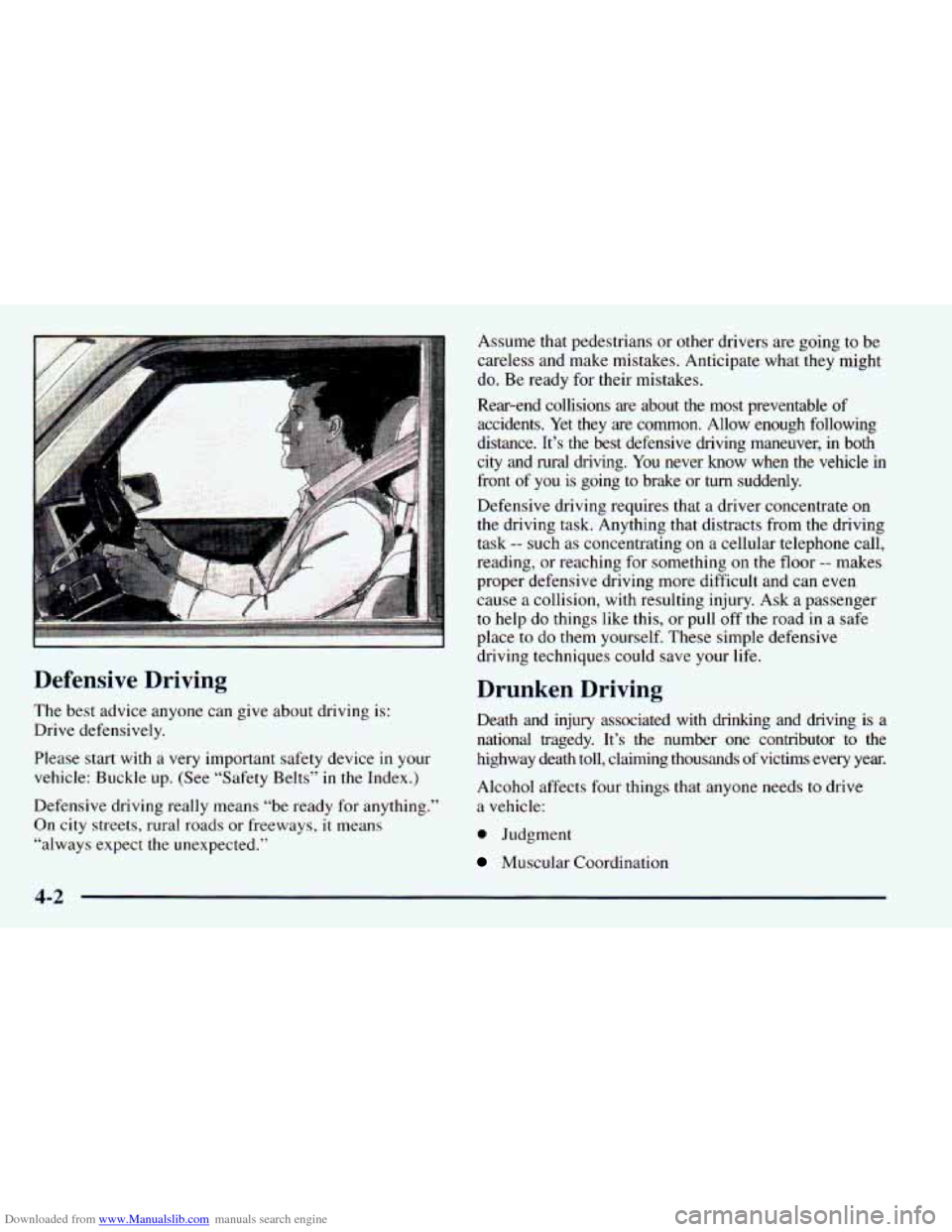
Downloaded from www.Manualslib.com manuals search engine -
Defensive Driving
The best advice anyone can give about driving is:
Drive defensively.
Please start with a very important safety device in your
vehicle: Buckle up. (See “Safety Belts” in the Index.)
Defensive driving really means “be ready for anything.”
On city streets, rural roads or freeways, it means
“always expect the unexpected.” Assume
that pedestrians or other drivers are going to be
careless and make mistakes. Anticipate what they might
do. Be ready for their mistakes.
Rear-end collisions
are about the most preventable of
accidents. Yet they are common. Allow enough following
distance. It’s the best defensive driving maneuver, in both
city and rural driving. You never know when the vehicle in
front of you is going
to brake or turn suddenly.
Defensive driving requires that a driver concentrate
on
the driving task. Anything that distracts from the driving
task
-- such as concentrating on a cellular telephone call,
reading, or reaching for something on the floor
-- makes
proper defensive driving more difficult and can even
cause
a collision, with resulting injury. Ask a passenger
to help do things like this, or pull
off the road in a safe
place to do them yourself. These simple defensive
driving techniques could save your life.
Drunken Driving
Death and injury associated with drinking and driving is a
national tragedy. It’s the number one contributor
to the
highway death toll, claiming thousands of victims every year.
Alcohol affects four things that anyone needs
to drive
a vehicle:
0 Judgment
Muscular Coordination
Page 200 of 414
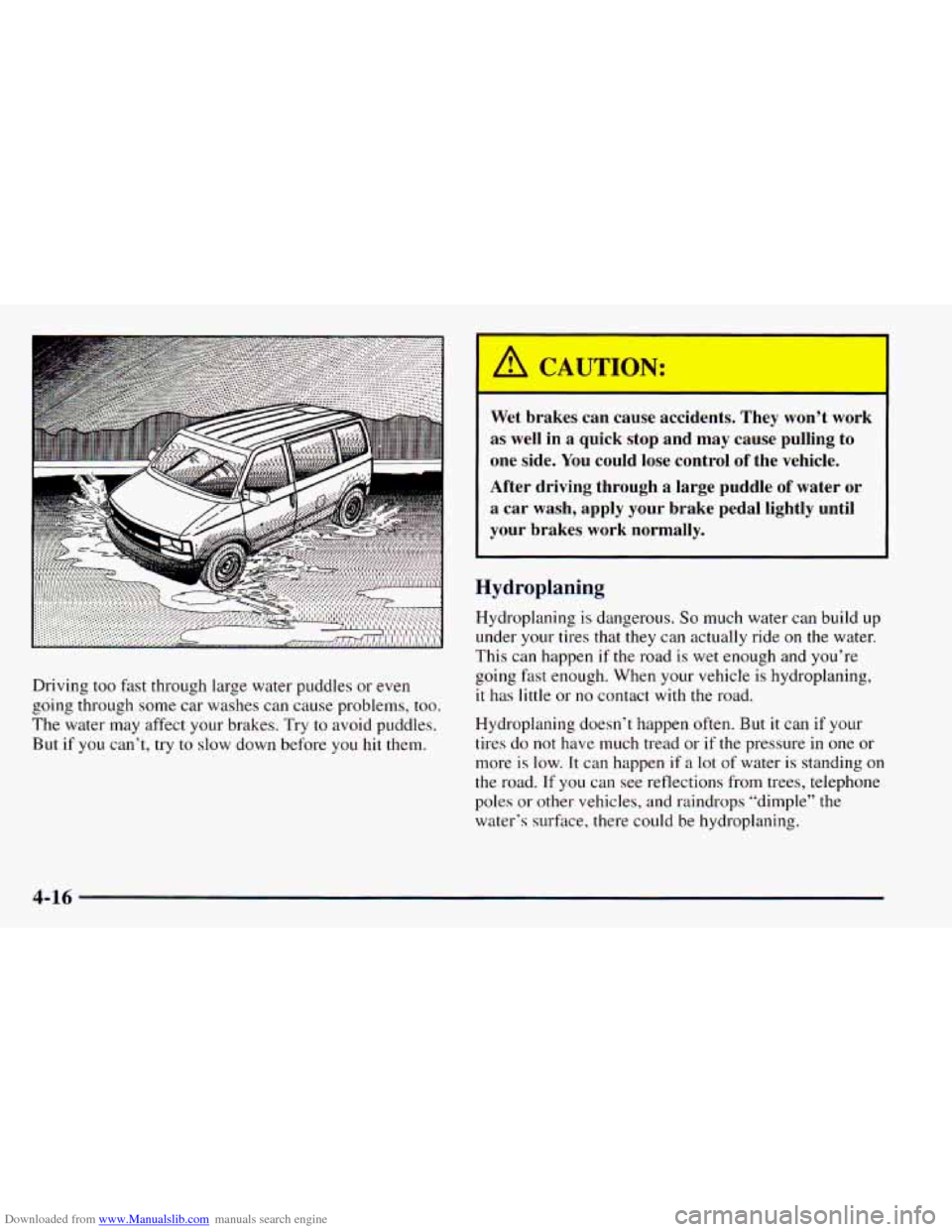
Downloaded from www.Manualslib.com manuals search engine Driving too fast through large water puddles or even
going through some car washes can cause problems, too.
The water may affect your brakes. Try to avoid puddles.
But
if you can’t, try to slow down before you hit them.
Wet brakes can causc xidents. They won’t work
as well in a quick stop and may cause pulling to
one side. You could lose control of the vehicle.
After driving through a large puddle of water or
a car wash, apply your brake pedal lightly until
your brakes work normally.
Hydroplaning
Hydroplaning is dangerous. So much water can build up
under your tires that they can actually ride on the water.
This can happen if the road is wet enough and you’re
going fast enough. When your vehicle is hydroplaning,
it has little or no contact with the road.
Hydroplaning doesn’t happen often.
But it can if your
tires do not have much tread or
if the pressure in one or
more
is low. It can happen if a lot of water is standing on
the road. If you can see reflections from trees, telephone
poles or other vehicles, and raindrops “dimple” the
water’s surface, there could be hydroplaning.
4-16
Page 385 of 414
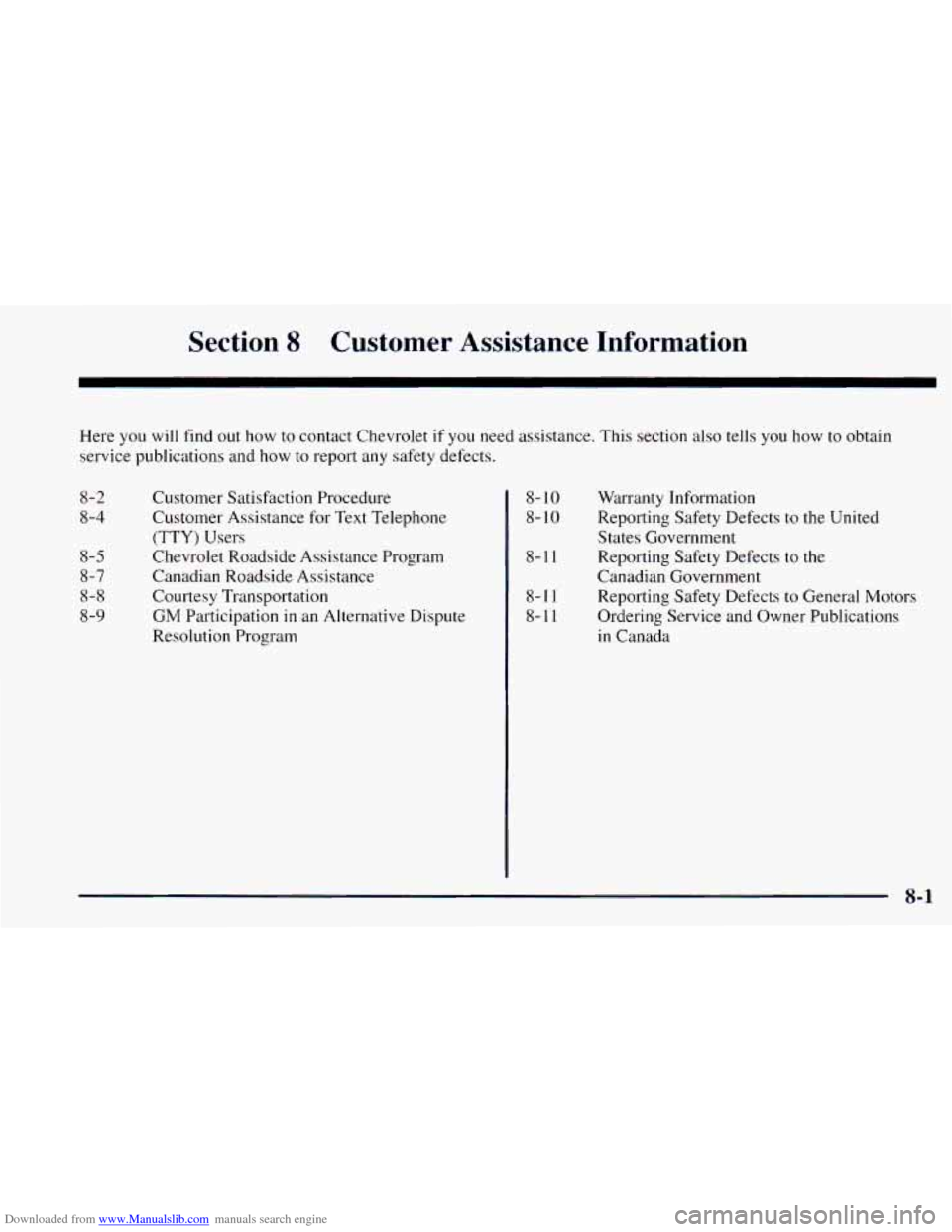
Downloaded from www.Manualslib.com manuals search engine Section 8 Customer Assistance Information
Here you will find out how to contact Chevrolet if you need assistance. This section also tells you how to obtain
service publications and how to report any safety defects.
8-2
8-4
8-5
8-7
8-8
8-9 Customer Satisfaction Procedure
Customer Assistance for Text Telephone
(TTY) Users
Chevrolet Roadside Assistance Program
Canadian Roadside Assistance
Courtesy Transportation
GM Participation in an Alternative Dispute
Resolution Program 8-
10
8- 10
8-1 1
8-1 1
8-1 1
Warranty Information
Reporting Safety Defects
to the United
States Government
Reporting Safety Defects
to the
Canadian Government
Reporting Safety Defects to General Motors
Ordering Service and Owner Publications
in Canada
8-1
Page 388 of 414
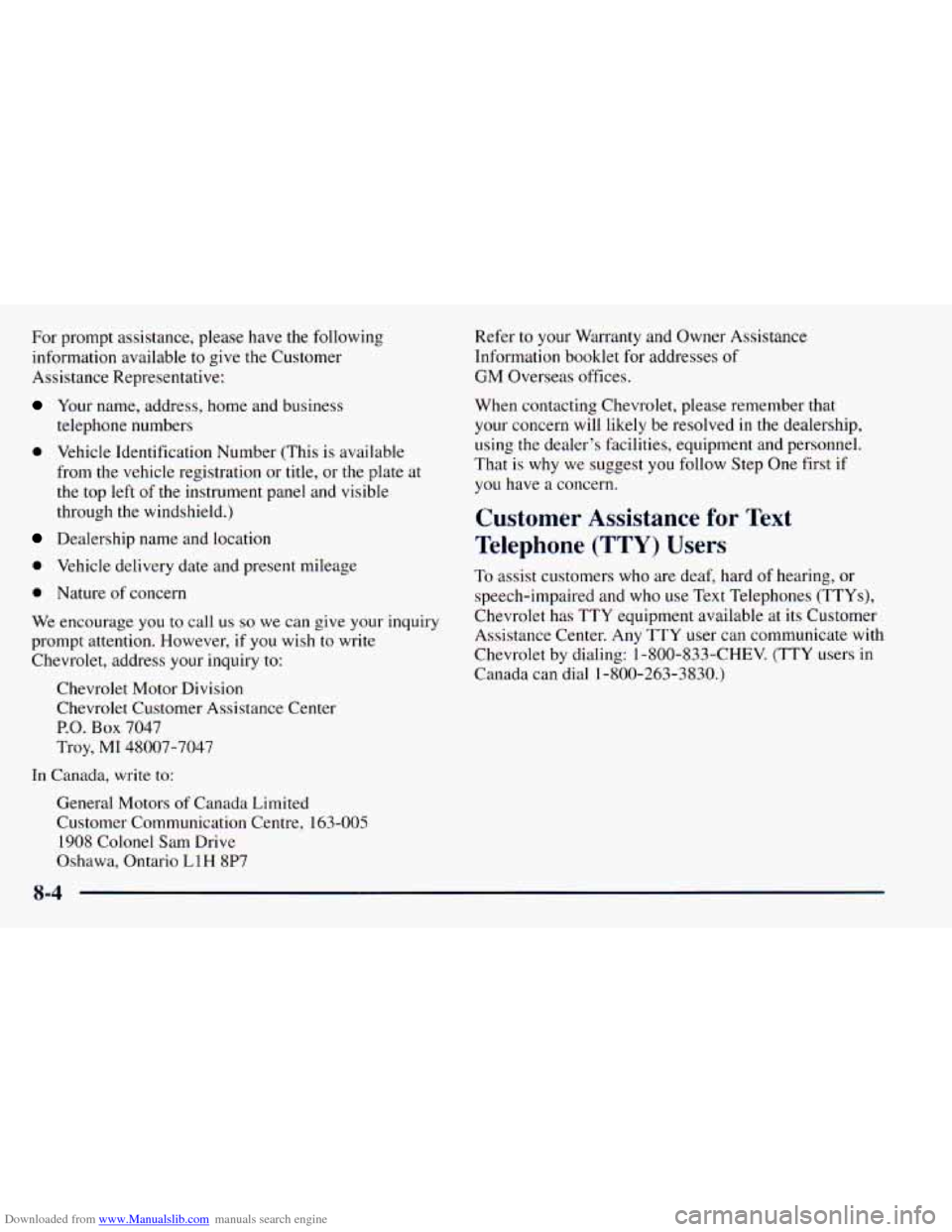
Downloaded from www.Manualslib.com manuals search engine For prompt assistance, please have the following
information available
to give the Customer
Assistance Representative:
Your name, address, home and business
telephone numbers
0 Vehicle Identification Number (This is available
from the vehicle registration or title, or the plate at
the top left
of the instrument panel and visible
through the windshield.)
Dealership name and location
0 Vehicle delivery date and present mileage
0 Nature of concern
We encourage you to call us so we can give your inquiry
prompt attention. However,
if you wish to write
Chevrolet, address your inquiry to:
Chevrolet Motor Division
Chevrolet Customer Assistance Center
P.O. Box 7047
Troy, MI 48007-7047
In Canada, write to:
General Motors of Canada Limited
Customer Communication Centre, 163-005
1908 Colonel Sam Drive
Oshawa, Ontario L1H 8P7 Refer to your Warranty and
Owner Assistance
Information booklet
for addresses of
GM Overseas offices.
When contacting Chevrolet, please remember that your concern will likely be resolved in the dealership,
using the dealer’s facilities, equipment and personnel.
That
is why we suggest you follow Step One first if
you have a concern.
Customer Assistance for Text
Telephone (TTY)
Users
To assist customers who are deaf, hard of hearing, or
speech-impaired and who
use Text Telephones (TTYs),
Chevrolet has
TTY equipment available at its Customer
Assistance Center. Any TTY user can communicate with
Chevrolet by dialing: 1-800-833-CHEV.
(TTY users in
Canada can dial 1-800-263-3830.)
Page 389 of 414
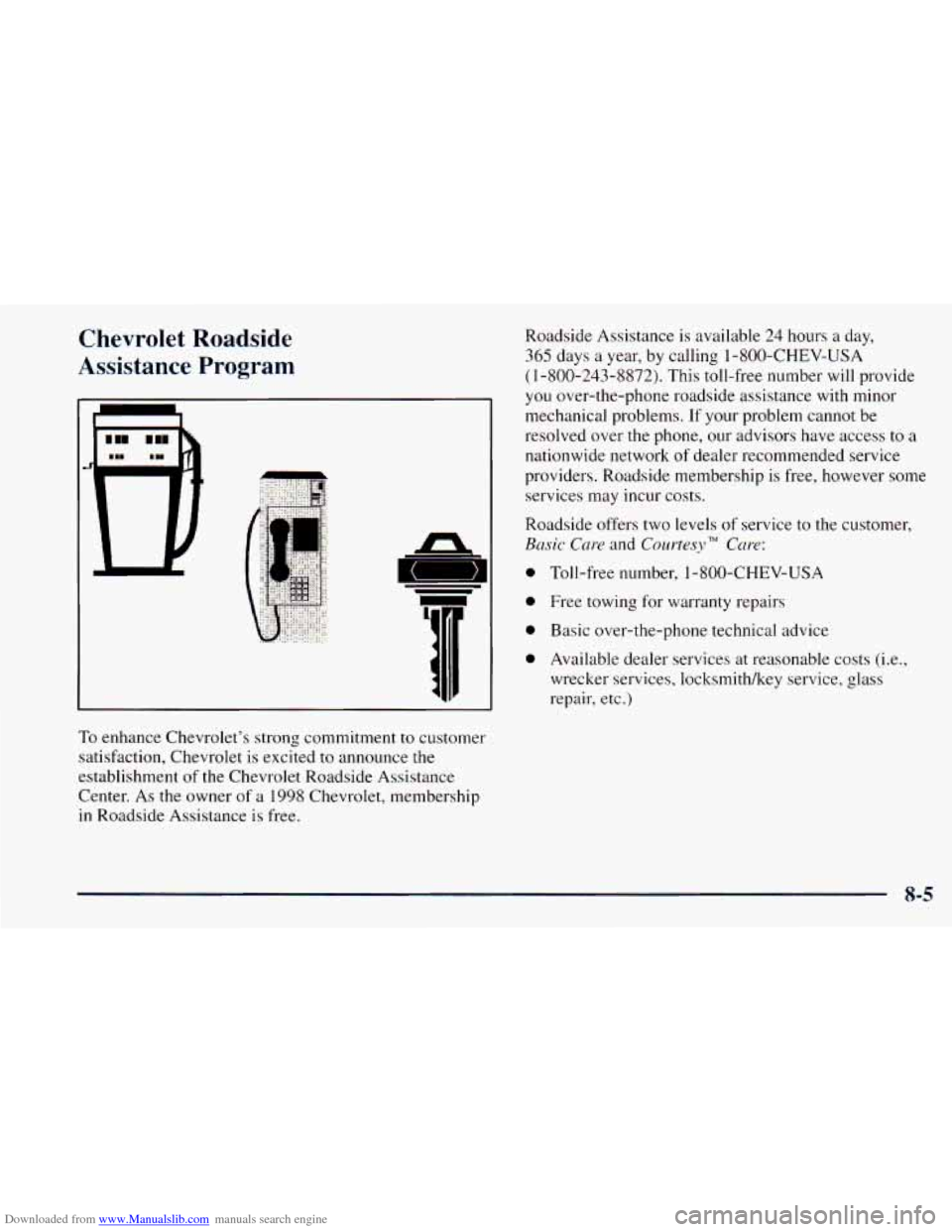
Downloaded from www.Manualslib.com manuals search engine Chevrolet Roadside
Assistance Program
n
To enhance Chevrolet’s strong commitment to customer
satisfaction, Chevrolet is excited to announce the
establishment
of the Chevrolet Roadside Assistance
Center. As the owner
of a 1998 Chevrolet, membership
in Roadside Assistance is free. Roadside
Assistance
is available 24 hours a day,
365 days a year, by calling 1-800-CHEV-USA
( 1-800-243-8872). This toll-free number will provide
you over-the-phone roadside assistance with minor
mechanical problems.
If your problem cannot be
resolved over the phone,
our advisors have access to a
nationwide network
of dealer recommended service
providers. Roadside membership is free, however some
services may incur costs.
Roadside offers two levels
of service to the customer,
Basic Care and CourtesyTM Care:
Toll-free number, 1 -800-CHEV-USA
Free towing for warranty repairs
Basic over-the-phone technical advice
Available dealer services at reasonable costs (i.e.,
wrecker services, locksmith/key service, glass
repair, etc.)